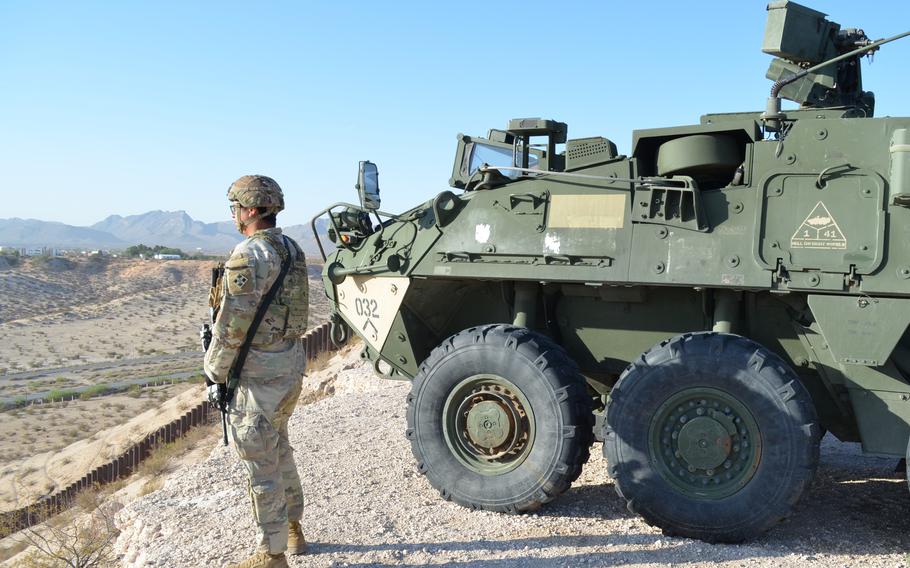
Army Pfc. Gerardo Casarez-Aguilar of the 2nd Brigade Combat Team, 4th Infantry Division at Fort Carson, Colo., on April 11, 2025, looks at the U.S. border with Mexico in Santa Teresa, N.M., where his unit is assigned to the detect illegal activity. (Rose L. Thayer/Stars and Stripes)
AUSTIN, Texas — More than 200 migrants have now been charged with trespassing in the new military zone along New Mexico’s southern border, yet service members still have not taken part in the physical arrests.
The military zone in New Mexico was established recently to give troops the jurisdiction to apprehend migrants crossing unlawfully into the United States from Mexico. But military operations at the southern border have largely remained the same. Service members detect the presence of people in the zone, called the New Mexico National Defense Area, and alert federal agents who make the arrests.
Troops still have not used their recently authorized power to detain people on the land, said Army Maj. Geoffrey Carmichael, spokesman for the Joint Task Force-Southern Border.
“I can confirm that task force personnel were instrumental in several detections that occurred, which resulted in swift apprehension carried out by the U.S. Border Patrol who were operating in close proximity to patrolling task force personnel,” he said. “I can also confirm task force personnel have neither made any detentions nor apprehensions of alleged trespassers within the national defense areas.”
Because troops work in such a close partnership with Customs and Border Protection officers, they have not had to take that next step themselves, he said. Those detained were migrants also charged with entering the U.S. without authorization, according to the Justice Department.
The cases of the people charged are in U.S. District Court in New Mexico, where the Army established the military zone last month. It is considered part of Fort Huachuca in Arizona. The area is roughly 170 miles long and 60 feet wide, stretch across much of the southern edge of New Mexico. It does not include any tribal lands.
A couple of weeks later, the Army established the Texas National Defense Area as part of Fort Bliss in El Paso. It extends east more than 50 miles from El Paso to the town of Fort Hancock. However, no one has been charged with entering this area yet, according to the Justice Department.
Roughly 6,600 soldiers and Marines are working along the southwest border, primarily in a support role to Customs and Border Protection. However, when the defense areas were established, troops were given additional authorities to temporarily detain anyone trespassing on the new military land — just as they would at any military base.
The border deployments first began in 2018 during President Donald Trump’s first term and continued under former President Joe Biden with about 2,500 National Guard at the border at the end of his administration.
When Trump returned to office in January, he ordered active-duty forces to the mission. More than 4,000 have deployed to the border. It is part of his goal of making border security a top priority for the military.
Trump ordered the creation of the military border zones to sidestep laws that prohibit the military from conducting civilian law enforcement.
People detained in the military zones can face a federal charge for trespassing on military land, which is a misdemeanor that carries the penalty of up to a year in custody and $100,000 in fines. More traditional illegal entry charges only hold a penalty of up to six months in jail and up to $5,000 in fines, according to The Washington Post.
Chief Magistrate Judge Gregory Wormuth in New Mexico ordered government lawyers last week to submit a brief explaining their view of the legal standards required to convict someone of trespassing on military property, according to the Post. He also asked whether defendants must have known it was military property to be found guilty.
The southern border task force said troops began installing signs on the land immediately after it was transferred into Army ownership. It will remain Army land for three years.